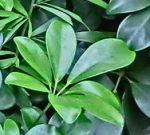 Also called octopus tree, Schefflera is an evergreen tree native to the rainforests in Australia, New Guinea, and Java where it grows up to 50’ tall. It was introduced into Florida in 1927 as an ornamental, escaped cultivation, and has become invasive in a variety of habitats including sand dunes, beaches, forests, and cypress stands. Schefflera can only survive in warm climates with temperatures above 35 F and is a problem in both Hawaii and Puerto Rico but is also a popular house plant in many parts of the US . When growing in natural areas, Schefflera has an aggressive root system and highly efficient seed dispersal method by birds, and shades out native species with its abundance of large attractive leaves. Once established it is very difficult to control because neither fire nor herbicides have proven effective in the long term. USDA Hardiness Zones 10-12
Also called octopus tree, Schefflera is an evergreen tree native to the rainforests in Australia, New Guinea, and Java where it grows up to 50’ tall. It was introduced into Florida in 1927 as an ornamental, escaped cultivation, and has become invasive in a variety of habitats including sand dunes, beaches, forests, and cypress stands. Schefflera can only survive in warm climates with temperatures above 35 F and is a problem in both Hawaii and Puerto Rico but is also a popular house plant in many parts of the US . When growing in natural areas, Schefflera has an aggressive root system and highly efficient seed dispersal method by birds, and shades out native species with its abundance of large attractive leaves. Once established it is very difficult to control because neither fire nor herbicides have proven effective in the long term. USDA Hardiness Zones 10-12
The following natives are recommended as alternatives:
Black Olive (Bucida buceras)
Native to the brackish marshes in the upper Florida Keys, this evergreen tree grows up to 50’ tall and has a full dense crown of bluish-green leathery leaves two to four inches long, and sometimes has spines on the branches. Some experts, however, do not think this plant is native. USDA Hardiness Zone 10-11
Wafer Ash aka Hop Tree (Ptelea trifoliate)
With small fragrant flowers and yellow foliage in fall, this small deciduous tree can also be grown as a shrub. It is native to wetlands from Ontario to Minnesota, south to Florida and northern Mexico. USDA Hardiness Zones 3-9
Jamaica Dogwood aka Florida Fishpoison Tree(Piscidia piscipula)
Native to coastal zones of southern Florida, Jamaica dogwood is a deciduous tree growing 45’ tall and bearing clusters of attractive white flowers tinged with pink or red in spring. USDA Hardiness Zones 9-11